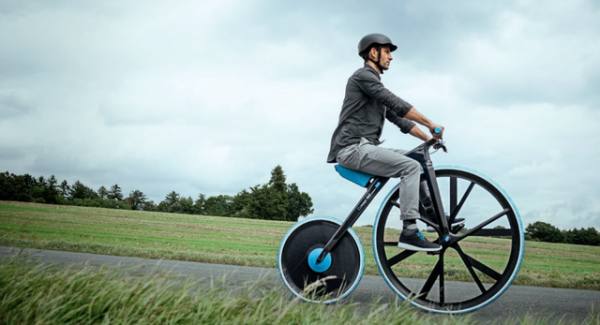

About
Conspicuous with its wheels of different sizes, the velocipede was the first pedal-powered cycle in history. DING3000 and the chemical company BASF have now rebuilt the 19th century bike as a modern e-bike. But why?
With the "Concept 1865", we are taking a trip back to the year 1865, when BASF was founded. This was also the point in time when Karl Drais’ wooden "Dandy horse" was given its first pedals, which launched the bicycle on the road to global success. As a tribute to this era of enthusiasm for technology and invention, DING3000 and BASF have embarked on an unparalleled thought experiment and asked:
How would the first pedal cycle have looked if the pioneers of the bike had had today’s advanced materials to work with?
In cooperation with BASF, DING3000 has developed the E-Velocipede "Concept 1865". It is a ready-to-ride prototype with an electric drive and 24 polymer applications, some of which are highly innovative like the bearingless all-plastic pedals made of Ultrason® or the light and punctureproof tires made of Infinergy®.
By implementing this design study DING3000 obviously does not intend to reinvent the bicycle, let alone the wheel. Under the slogan »Rethinking Materials«, the unusual e-bike is in fact an invitation to customers to join the company in developing new applications and product ideas utilizing advanced plastics. It is an invitation to question the status quo and create something new – just as the pioneers of cycling did in their time.
The crank made of Ultramid® D withstands high stressing, such as when the rider mounts the cycle or climbs steep hills. With Ultrason® integral pedals completey out of plastic and without ball-bearings could be provided.
Infinergy® is the first expanded thermoplastic polyurethane. It is light, durable and very elastic, while also displaying outstanding resilience.
The spring-loaded slide is pulled at the rear within the recessed grip to unlock and remove the seat. The seat of the Concept 1865 is supported by a Cellasto® spring element for excellent sprung comfort.
Descreet power: The inside of the detachable saddle contains the battery for the electric drive. Recharging the battery at home keeps the saddle dry, clean and warm.
Brake hoses made from Elastollan® exhibit optimal bursting behavior under pressure, are highly wear resistant and permit the tight bending radii that are essential on bikes. The transparent Elastollan used here also renders the oil inside visible and thus makes it easier to check bubble-free filling and hence reliable braking behavior. Thanks to these transparent hoses, it was possible to have the a color accentuation with a dyed oil.
Inconspicuous help: A 250W electric drive is integrated within the rear wheel and renders a descreet support.


